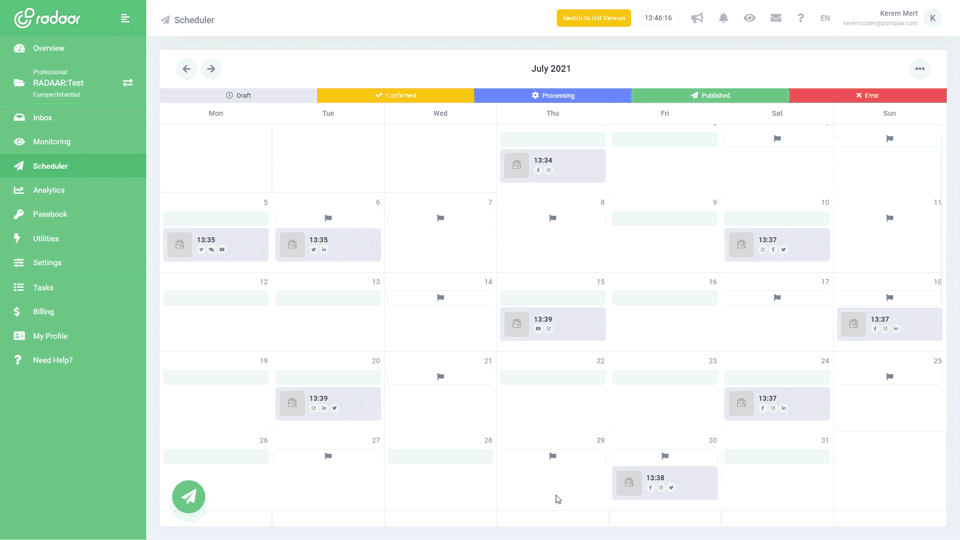Have you ever wondered why customizing content for each social media platform matters?
Discover why tailoring your content for each social media platform can skyrocket your engagement and boost your brand’s visibility. Dive into our latest blog post to learn the secrets of crafting platform-specific content that truly resonates!
LEARN MORE LAUNCH DEMO NOW Have you ever wondered why customizing content for each social media platform matters? In today's digital age, where social media dominates the way we communicate and consume information, tailoring your content to fit the unique characteristics of each platform is crucial. Different social media channels have distinct audiences, formats, and engagement patterns, meaning a one-size-fits-all approach simply won't cut it. In this blog post, we'll delve into the importance of customization and how it can significantly enhance your social media strategy.
Customizing content isn't just about changing the dimensions of your images or shortening your text. It's about understanding what resonates with users on each platform and leveraging those insights to maximize engagement and reach. Whether it's tapping into the visual storytelling capabilities of Instagram, the professional tone required on LinkedIn, or the concise messaging needed for Twitter, each platform offers unique opportunities to connect with your audience in different ways. Join us as we explore the nuances of each social media channel and how to tailor your content to thrive in this diverse digital landscape.
Customizing content isn't just about changing the dimensions of your images or shortening your text. It's about understanding what resonates with users on each platform and leveraging those insights to maximize engagement and reach. Whether it's tapping into the visual storytelling capabilities of Instagram, the professional tone required on LinkedIn, or the concise messaging needed for Twitter, each platform offers unique opportunities to connect with your audience in different ways. Join us as we explore the nuances of each social media channel and how to tailor your content to thrive in this diverse digital landscape.
Table of Contents
- What are the unique audiences of each platform?
- How do platform algorithms affect content reach?
- Which content formats work best per platform?
- Why is brand voice consistency across platforms important?
- How does engagement vary across social platforms?
- What role do hashtags and keywords play?
- Why is audience interaction crucial on each platform?
- Which tools help customize content efficiently?
- Ready to customize your content for better engagement?
What are the unique audiences of each platform?
Each social media platform is like a unique gathering place for different groups of people, each with their own interests and behaviors. For instance, Instagram is a hotspot for visually-driven millennials and Gen Z users who love sharing images and short videos. LinkedIn, on the other hand, attracts professionals looking to network and share industry insights. Meanwhile, Facebook tends to have a more diverse age range, making it a great place to connect with family and friends while sharing a mix of content types.
How do platform algorithms affect content reach?
Platform algorithms play a crucial role in determining how far and wide your content travels. Each social media platform uses its own set of rules to decide which posts appear on users' feeds, often prioritizing content that's highly engaging or fits specific criteria. By customizing your content to meet these unique algorithmic preferences, you're more likely to boost visibility and engagement. Ignoring these differences can result in lower reach, wasting your creative efforts.
Which content formats work best per platform?
When it comes to choosing the best content formats for each social media platform, understanding the unique strengths of each network is key. Instagram thrives on visually appealing images and short, engaging videos, making it ideal for high-quality photos and reels. Facebook, a versatile platform, supports a mix of text, videos, and images, allowing for detailed posts, live videos, and event announcements. On Twitter, brevity is king, so concise tweets, quick updates, and engaging GIFs tend to perform best, while LinkedIn favors professional articles, industry insights, and thought leadership posts.
Why is brand voice consistency across platforms important?
Brand voice consistency across platforms is crucial because it helps build trust and recognition among your audience. When people encounter a familiar tone, whether they’re on Instagram, Twitter, or LinkedIn, they instantly connect it to your brand. This seamless experience ensures that your messaging resonates effectively and maintains credibility. Plus, a consistent voice across all channels makes your brand feel cohesive and professional, which can significantly boost engagement and loyalty.
How does engagement vary across social platforms?
Engagement varies significantly across social platforms because each platform attracts different audiences who interact uniquely with content. For instance, Instagram and TikTok are highly visual and rely on eye-catching images and videos to drive likes, comments, and shares, making them ideal for creative and visually appealing posts. On the other hand, Twitter thrives on short, succinct messages and trending hashtags, which encourage fast-paced conversations and retweets. LinkedIn, being more professionally oriented, sees higher engagement with industry insights, white papers, and professional achievements, fostering thoughtful comments and shares among business-minded individuals.
What role do hashtags and keywords play?
Hashtags and keywords play a crucial role in enhancing the visibility and engagement of your social media content. They act as digital signposts, guiding users to relevant posts and topics, making it easier for audiences to discover your content organically. By tailoring hashtags and keywords to fit the unique ecosystems of each platform, you increase the chances of your posts being seen by the right people. This keyword optimization ensures that you're not just broadcasting messages into the void but actually connecting with users interested in what you have to offer.
Why is audience interaction crucial on each platform?
Audience interaction on each social media platform is crucial because it helps build a sense of community and trust among your followers. Different platforms have unique user behaviors and engagement styles, meaning what works on Instagram might not resonate on Twitter. By actively engaging with your audience, you can gather valuable feedback and insights that help refine your content strategy. Ultimately, meaningful interactions drive higher engagement rates, increase brand loyalty, and amplify your reach.
Which tools help customize content efficiently?
One of the key tools to help customize content efficiently for different social media platforms is Hootsuite, which allows you to tailor and schedule posts according to each platform's unique requirements and audience behaviors. Canva is another versatile tool, offering templates and design elements to ensure your visuals are optimized for each network's specifications. Another valuable tool is Buffer, which provides analytics to help you understand what type of content performs best on each platform and when to post it. Lastly, CoSchedule's Headline Analyzer ensures your headlines and captions are engaging and platform-specific, making your content more appealing and effective.
Ready to customize your content for better engagement?
Ready to customize your content for better engagement? As we've explored, tailoring your content for each social media platform isn't just a suggestion; it's essential for maximizing reach and engagement. By embracing the unique features and culture of each platform, you can deliver more relevant and engaging content to your audience. This approach not only enhances the viewer's experience but also increases the likelihood of your content being shared, liked, and commented upon.
Taking the time to customize your content shows your audience that you understand their preferences and are committed to delivering value. Remember, it's not about spreading yourself thin but about being strategic and intentional with your messaging. Use the strengths of each platform to your advantage and watch your engagement rates soar. So, start today—analyze, adjust, and see the difference it makes in your social media strategy!
Taking the time to customize your content shows your audience that you understand their preferences and are committed to delivering value. Remember, it's not about spreading yourself thin but about being strategic and intentional with your messaging. Use the strengths of each platform to your advantage and watch your engagement rates soar. So, start today—analyze, adjust, and see the difference it makes in your social media strategy!
SOCIAL MEDIA SCHEDULER
Plan and publish...
Plan and publish your content for Facebook, Instagram, Twitter, and LinkedIn from one simple dashboard.
LEARN MORE FREQUENTLY ASKED QUESTIONS
What is social media management platform?
RELATED BLOG POSTS
All the tips & tricks you'll need...
Get the fresh tips and tricks you'll need to ace social media marketing.














